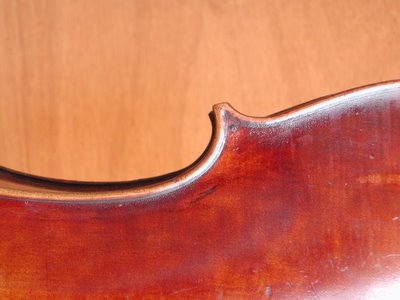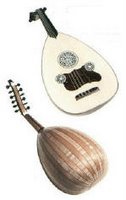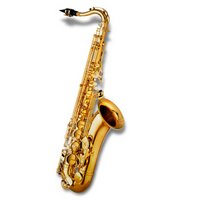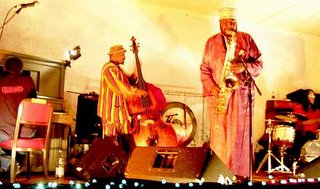
There are promising signs of the emergence of a young cohort of
very accomplished jazz musicians with a distinctly contemporary
style that could transform itself into something unique in terms
of our cultural context within the next five years or so.
At this juncture there is amazingly close familiarity with
American jazz idioms among the old-timers; we see this in the
performances not only of key homegrown jazz musicians like
Billy Martinez (string bass), Jeremy Monteiro (piano), Louis Soliano
(drums), Boni de Souza (piano), Steven Rufus (tenorist) or Boon Chye
(tenorist)as well as many of the key members of the Thomson
Jazz Band like Fabian Lim (altoist) in addition to the man
behind the Thomson Jazz group - architect & self-made musician -
Eddy Chan (vibes); not forgetting talented fine female vocalists like
of Jacintha, Rani, Claressa, Anne, Corinne, Olivia as well as Singapore's rare Latin jazz flautist- Wendy Low, in addition to the big sound of male vocalist cum baritone saxist, Jerry Hutapea. However, with the exception of frontline instrumentalists like Rufus & a handful of his contemporaries who keep up with the changing times, it is largely among the younger talents like, Leo Mendoza (altoist), Budi Winarto (tenorist) or Dave D'aranjo (electric bassist); Dr. Malcolm Mah (electric bassist) that we are more likely to experience some semblance of 'avantgarde' (if not yet
cutting edge)jazz - frequently characterized by idiosyncratic structures a la
free jazz or radical post-bopical patterns of improvisation.
Among the mature talents, Clinton Carnegie (electric guitarist/bassist) - a past Yamaha prize-winning guitarist, who demonstrates marvellously fluent fretwork in
Ian's Groove (an original) in addition to close intimacy with the techniques of past masters like Joe Pass or Wes Montgomery as well as
experimenters like John McLaughlin (Mahavishnu Orchestra);
yet, one would hope to see more cutting
edge work like that emerging from young Stateside contemporaries
like Kurt Rosenwinkel (of Next Step, Deep Song & Heartcore fame)
&, of course, Grammy Award winner, Marcus Miller.
Young Dave D'aranjo who's probably not yet out of his teens
reveals a magical rumble of low-frequency lyricism bordering on
poetry in his
Who Loves Ya, Jaco (an orginal dedicated to the
king of electric bass: Jaco Pastorius). Both tracks can be found
on the
Jazz in Singapore CD from kingsworld - which attempts,
but does not quite achieve, justice in providing an accurate picture
of what jazz in Singapore is all about...
Anyway, the skill & creativity these artistes display provide us with
the hope that Singapore will go international sooner rather than later;
these are talents that shouldn't be left to blush unseen (or rather
'unheard') away from international music audiences since they
possess the capacity to do Singapore proud in the context of
cutting edge creativity in the arts; we should treat them like jazz
ambassadors who can help nudge Singapore onto the global jazz map...
But one small cautionary note needs to be sounded: to date it is
difficult to discern close mergence between the modes of jazz & the
music of our Asian mother cultures. Ironically, the examples might
actually have to come by way of models on the outskirts of international jazz like Jobim, Trilok Gurtu, Rubalchaba, the Mahavishnu Orchestra et al... In attitudinal terms it might require the breaking down of
ethnic cultural barriers through cross-over music appreciation;
much has yet to be done in the way of extending exposure to world
music & the use of Asian instruments in jazz performances in
Singapore.
However, the merging of the cultures should not quite lead to
the situation where jazz is almost completely overwhelmed -
as appears to be the case with the new sound of Joe Zawinul &
his Syndicate in
World Tour (Zebra Records, 1998)which
is basically a conversion to world music; the only fragile links
with jazz coming from Zawinul's acoustic piano & the bass
improvisations of Victor Bailey & Richard Bona...But the move
in the direction of world music is not unexpected since even jazz
can be seen as the ethnic music of North America & all ethnic
cultures are likely to come under threat from globalisation. But
the roots of jazz suggest that - according to some jazz journalists
- jazz itself was the prototype world music: a blend of african &
european musical traditions. Now jazz is America's classical music
(a la Lincoln Center).
However, looking at the Singapore situation what still holds true
is that more could be expected from arts organizations in terms of
a sustained & intelligent strategy which needs to maximize
attention to the developmental aspects of fusing Asian and Western
music by enhancing the merging of instrumentalists from polar
traditions through the provision of support facilities or
funding for these heritages to meet on the same stage. In
this respect witness the resounding success of vocalist
Susheela Raman who emerged from a strictly traditional
South Indian musical base & yet made it to first prize
as BBC World Music newcomer mingling South Indian
with Western modes & techniques...
The Esplanade, especially with its Mosaic music programme
is doing a marvellous job of providing us with access to
some of the best from the global music scene (Ustad Zakir
Hussain, Shirley Horn, Joshua Redman, Poncho Sanchez, Paquito
D'rivera, Leroy Jones, Kenny G, Chris Botti, Youssou N'Dour
etc...). Not forgetting the inimitable Scandinavian jazz of
Jan Gabarek who gave a full audience a taste of what a
distinctly non-American jazz sounds like...
NB George Benson will be at the Esplanade in December this year.
It is notable that while smooth jazz artistes like Botti &
Benson have been invited for performances at the Esplanade their
appeal seems to be more to the general music listening audiences
rather than jazz musicians since not many of the latter are
familiar with the music of the smooth jazz crowd; the Singapore
jazz musician seems to be somewhat conservative in musical taste:
the preference seems to be for swing & jazz standards rather
than fresh strands a la Boney James, Peter White, Kirk Whalum,
John Scofield or Kim Waters... (Perhaps, it might even be a
case of musical snobbery - there might be a case for a
more relaxed musical environment in jam sessions).
It must be admitted that Singapore has attracted
accomplished foreign talent to direct its jazz
programme eg Tim O'Dwyer who heads the department
at LASALLE. A saxophonist of impressive stature in
the realm of experimental jazz a la Evan Parker,
his influence needs to be felt far more widely than
it is at the moment since one of the stultifying
features of the Singapore jazz scene is the
ossifying tendency to equate jazz with only old-time
swing. O'Dwyer introduced experimental jazz - perhaps
for the first time in Singapore's music history - with an
electrifying John Coltrane celebration recital at the Esplanade
on 12th March 2007.
But I digress; to cast the net more widely - and I am
sure many music critics & ethnomusicologists will be
inclined to agree with me here - Singapore is in the right
context to produce world music award winners like
Susheela Raman (not that award winning is the sole
criterion of musical excellence - but it certainly
helps the cause). The wonder, to date, is why it
is taking so much time...
But there are encouraging signs apparent; hopefully, we
shall soon have our quota of world-beating musicians for
the global jazz community - a befitting tribute to Singapore's
status as a significant global city.
And talking about global city, not longer after Sadao Watanabe
presented a rhythmically Africanised concert on Nov. 28 '07 -
courtesy of his Senegalese percussionist N'diasse Niang -
along came David Sanborn with his screamingly funky American
jazz in a not-to-be-missed encounter at the same venue:
Esplanade Concert Hall! And they stood up more than once for
Sanborn & for Singapore - the growing global city...






